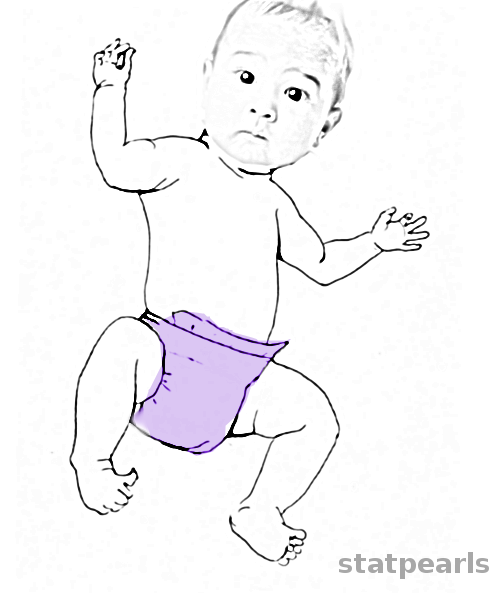
Moro Reflex
- Article Author:
- Christopher Edwards
- Article Editor:
- Yasir Al Khalili
- Updated:
- 8/30/2020 9:43:25 AM
- For CME on this topic:
- Moro Reflex CME
- PubMed Link:
- Moro Reflex
Definition/Introduction
The Moro reflex is a normal primitive, infantile reflex. The Moro reflex is an involuntary protective motor response against abrupt disruption of body balance or extremely sudden stimulation.[1] Ernst Moro first described the Moro reflex in 1918. It can be seen as early as 25 weeks postconceptional age and usually is present by 30 weeks postconceptional age.[2] The reflex is present in full-term infants and begins to disappear by 12 weeks with complete disappearance by six months.[3]
The reflex is elicited by pulling up on the infant's arms while in a supine position and letting go of the arms causing the sensation of falling.[1] Production of the reflex is by the suddenness of the stimuli and not the distance of the drop. There is no need to lift the infant's head off of the bed to elicit this reflex. The normal Moro reflex starts with the abduction of the upper extremities and extension of the arms. The fingers extend, and there is a slight extension of the neck and spine. After this initial phase, the arms adduct and the hands come to the front of the body before returning to the infant's side.[3]
Issues of Concern
The Moro reflex is particularly weak in preterm newborns because of lower muscle tone, inadequate resistance to passive movements and slow arm recoil, compared with those of full-term newborns at the same post-conceptual age.[4] The absence of the Moro reflex during the neonatal period and early infancy is highly diagnostic, indicating a variety of compromised conditions.[3]
Clinical Significance
The absence or premature disappearance of the Moro reflex can result from a birth injury, severe asphyxia during the birthing process, intracranial hemorrhage, infection, brain malformation, general muscular weakness of any cause, and cerebral palsy of the spastic type.[5][1] Asymmetrical Moro can be due to a local injury. Damage to a peripheral nerve, cervical cord, or a fracture of the clavicle are common causes to an asymmetric Moro and causes inhibition of the reflex on the affected side.[3][6] Prolonged retention of the Moro reflex can also be a sign of spastic cerebral palsy.[5]
In one study, the presence or absence of the Moro reflex is more related to the development of the infant and less likely pertains to pathogenic conditions.[4] Another study showed a clear association between retained primitive reflexes and delay in motor development in very low birth weight infants.[7] Training on how to perform moro reflex correctly among healthcare workers is important and can improve the yield of the physical examination.[8]
Nursing, Allied Health, and Interprofessional Team Interventions
The Moro reflex is a normal reaction to stimuli of an infant, and it is essential for the entire healthcare team to understand what a normal reaction looks like and when to be concerned. Often families will have questions and concerns about their developing child. While a physician can comfort and address concerns, it is often the front line nursing staff in the hospital or a clinic environment that are first available to address parental concerns and recognize concerning finding. Identifying abnormalities early can then lead to the inclusion of physical therapy, occupational therapy, neurology, and developmental specialist into the care of a child.
It is crucial to the entire interprofessional team, including the nurses, recognize that an asymmetric Moro reflex at birth can be indicative of neuronal damage or a clavicular fracture.[6] Also, it is necessary to remember that the Moro reflex should disappear by six months of life and a retained reflex should raise suspicion for gross motor delay and possible spastic cerebral palsy.[5][7]
